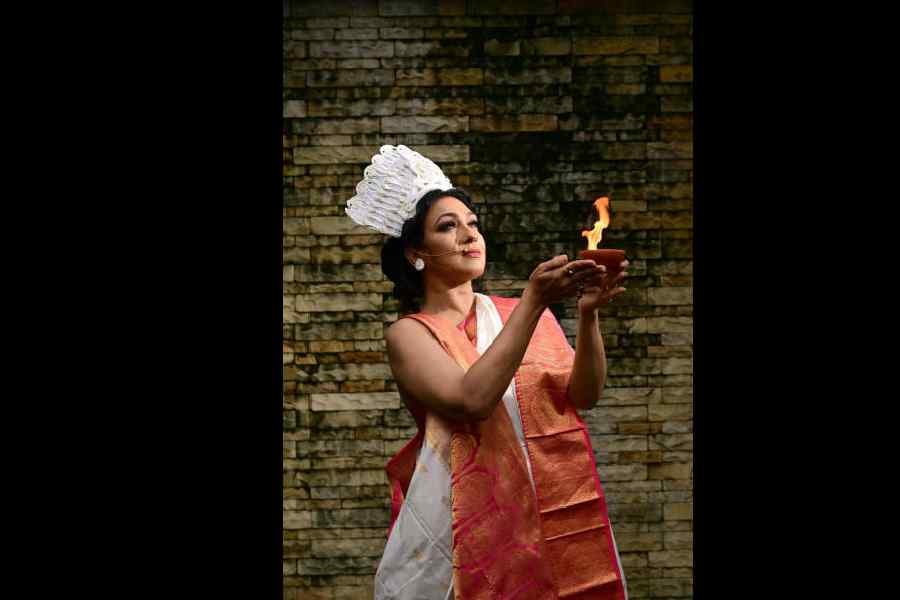Kaliprasanna Singha’s novel Hootum Pyanchar Naksha, where through satirical writing, Singha sketches the 19th-century urban society of Bengal, its traditions and the various elaborate religious celebrations, mentions the arrival of artisans from Krishnanagar at Kumartuli and Siddheshwaritala during this grand festival to create the ornamental pieces that would be required to adorn the clay figure of the Goddess. Ornaments have always been associated with a woman’s pride and have been used to enhance her beauty.
According to mythology, just like the Gods and Goddesses bestowed Maa Durga with her weapons for fighting Mahishasura, nature decked her up with ornaments made of natural elements. But over the years, Maa Durga’s ornamentation has undergone certain changes.
Earlier, the artisans decked up the Goddesses with clay ornaments in the process of making the idol. Gradually, when Durga Puja was popularised in Bengal by Raja Krishnachandra Roy of Krishnanagar, the Puja was all about flaunting the Nawabi wealth. Debir saaj was an important part of the Puja and initially, it was all about featuring exaggerated motifs of human ornaments. That tradition still prevails.
It was Raja Nabakrishna Deb’s 18th and 19th-century puja in Calcutta that introduced daaker saaj as a type of ornamentation. It gained much popularity over the years. The expensive process involved wire, silver foil, sequins and zari as the raw materials, most of which were exported from Germany, thus giving it its name daaker saaj (where daak referred to the postal system).
The other form of ornamentation is the sholar saaj or the adornments created out of sholapith, a kind of water weed growing in the marshy lands of Bengal. It is the Malakar sect (the florists) that introduced this cheaper variety of daaker saaj. The Bonkapasi village in Bardhaman has a cluster of shola artisans, especially women, well known for this craft. Other clusters of artists exist in Nadia and Krishnanagar as well apart from the more contemporary ones in Kumartuli.
The ornaments used for adorning the Goddess include the aanchal or the palla, the crown or mukut, the neckpieces and pendants or maala and kantha, the kalkas for the ears, makar beni and ghar beni hanging from behind the ears, the betel leaf kalka for the ears, ornaments for hand and feet. The artisans, for whom this art is a patient practice, make these ornaments featuring designs inspired by nature, local and indigenous motifs like the bratalpana or the wish-fulfilment designs or geometric patterns.
The works of these artistes and artisans arrive in Calcutta a few days ahead of Mahalaya or right after Mahalaya when the idol-making process is complete. Right after Mahalaya, t2 in this fashion lookbook explores shola art to highlight this delicate craft exclusive to Bengal by adorning actress Rituparna Sengupta in Debir Saaj, highlighting one aspect of the entire ornamentation in each look. A pink palette is chosen for the drapes to complement the bright white of the shola art.

(left) To showcase the regal ornaments like the mukut or the crown and the bukpat or the chest ornament, Rituparna flaunted the bright pink jamevar silk sari from the handlooms of Varanasi. The play of pink shades in the weave and the zari highlights make this sari stand out.
(middle) For the hand and feet ornaments, Rituparna wore a beige and bright pink Paithani sari designed with the stunning meenakari peacock motifs on the palla. Rajat and Kaushik styled this regal look by highlighting the forehead as well with a shola bindi and a dash of red vermilion to add to the Vijaya Dashami debi baran vibe of the look.
(right) To highlight the aanchal adornment and the bukpat or the chest ornament, Rituparna donned this beautiful light pink Benarasi sari highlighted with traditional zari detailing and Benarasi motifs. Simple make-up adds to the charm of the entire look.
EXPERT SPEAK:

“Earlier it was daaker saaj, where the foil used to come from Germany in the mail, which is why they used to call it the daaker saaj, but otherwise the traditional saaj of Durga is the complete white decoration that is made of shola. The artisans first make the design on paper and then the shola pieces are cut into the ornamentation. That’s the process the artisans follow. The basic ornaments used in Durga’s decoration have remained the same over the years. Now, contemporary artistes rework on those, of course. There is a whole piece that covers the chest, there is an arm cover, the mukut and some other pieces — all of these have a traditional prescription that they follow. The artisans have formulas based on which these ornaments are made and these are not calculated by inches or metres rather they measure it with their finger span. They have these formulas which all the artisans know. Now the designers are coming in and it is all a little different. The very good saaj people are from Krishnanagar and there are centres in Kumartuli. The Puja is no more the old Puja, now it is only a show of designs. But the traditional saaj is the same. The designs used are all decorative but of a certain kind, where one can spot floral motifs like padma (lotus) and golap (roses) and others that are associated with Durga Puja,” said Nandita Palchoudhuri, folk art curator.
HAIR AND MAKE-UP:

“This is a shoot, where we used the traditional ornamentation of Maa Durga to create the looks. The various elements of sholar saaj have been used to style each look and for each look, as the colour palette of the saris was the same, we attempted different drapes. All can attempt these drapes. Since the jewellery we used in the shoot was heavy and the saris were gorgeous, we used light make-up. Black and brown smudged kohl eyes with lots of mascara and a minimal base, instead of much sheen and shine. We have used vermilion bindis. For the hair, we used tongs, soft curls or waves to create the look resembling those of the idols, but looks that can be easily created for you to go with gorgeous saris,” said Kaushik and Rajat, hair, make-up and styling duo.
Styling, hair and make-up: Kaushik and Rajat
Saris: Indian Silk House Exclusives
Location: The Park Hotel
